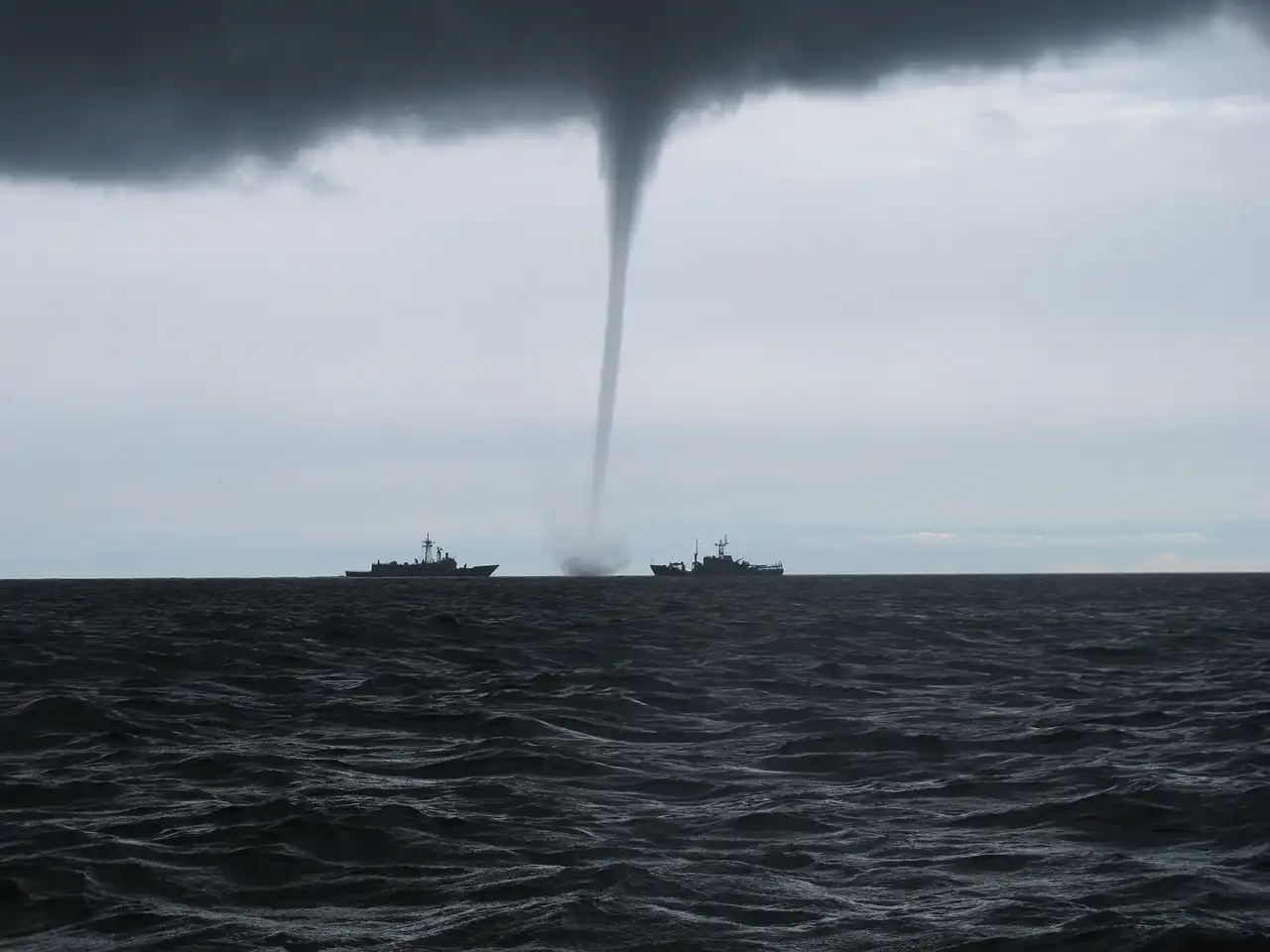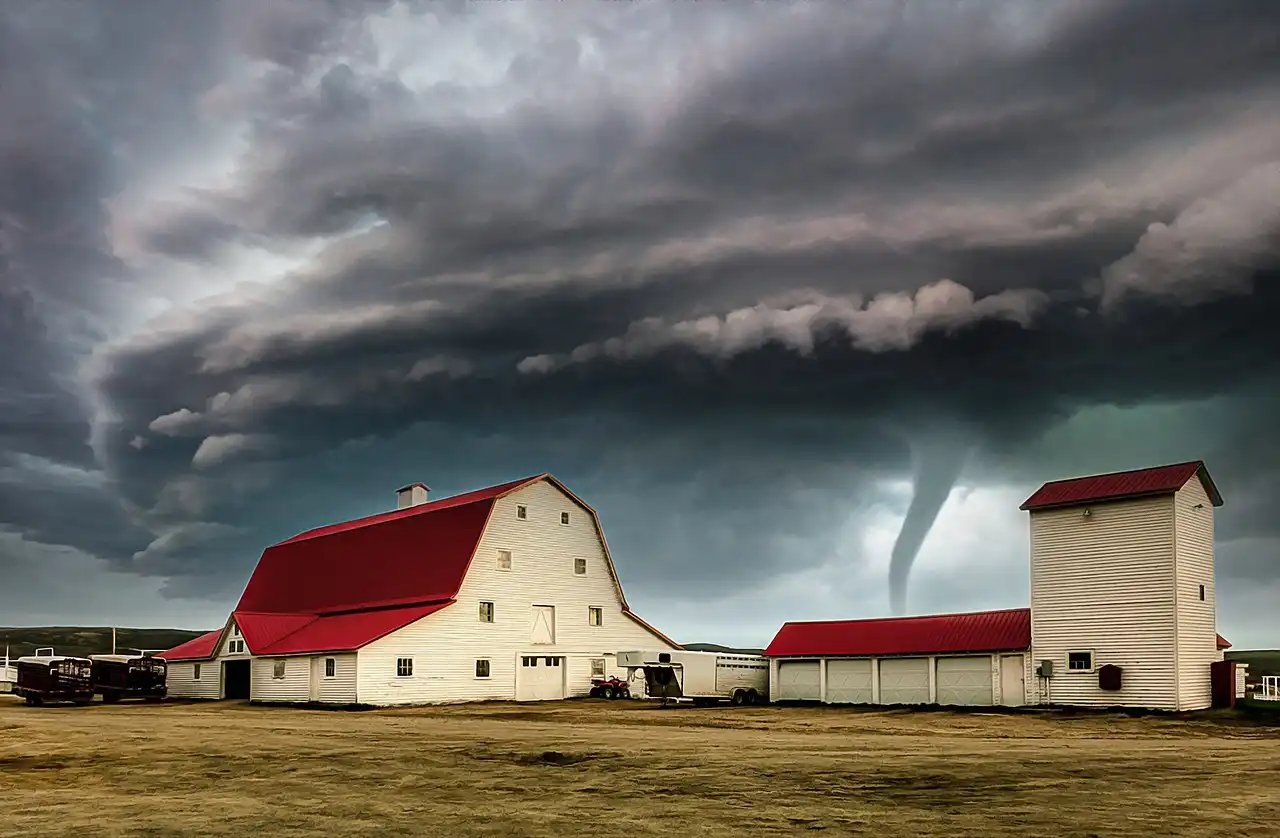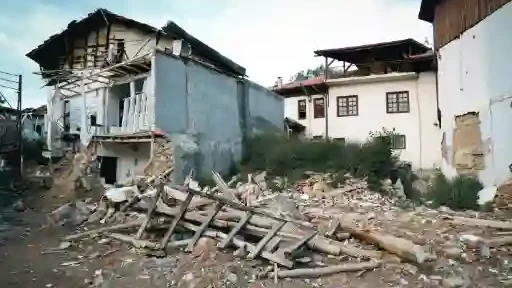
Did you know that a tornado can unleash wind speeds surpassing 300 miles per hour? Or that they can barrel across the terrain at velocities reaching 70 miles per hour? Tornados represent awe-inspiring and formidable natural events that continue to captivate and intimidate us. In this exploration, we’ll unveil 10 Facts About Tornadoes that will surely leave you in wonder!
From the most colossal tornado ever documented to the peculiar shapes and hues they can assume, there’s a wealth of knowledge to uncover about these weather storms tornadoes. We’ll probe into the scientific underpinnings of tornado genesis, their ruinous potential, and even some obscure facts that will undoubtedly astonish you.
Whether you’re a meteorology aficionado or just intrigued by the power of Mother Nature, this article is an essential read. Uncover the reasons behind the frequent tornado occurrence in certain locales, the methodology behind their classification, and the staggering destruction they’re capable of inflicting.
Prepare to be enthralled as we demystify the enigmas and marvel at the formidable might of tornadoes. Strap in and embark with us on a journey to the vortex’s core with these 10 astonishing tornado facts, brought to you in part by the National Weather Service’s tornado watch advisories!
The Formation of Tornadoes
Tornadoes emerge from potent thunderstorms, yet not all thunderstorms give rise to a tornado. To grasp how tornadoes form, it’s crucial to scrutinize the atmospheric dynamics at play. Initially, warm, humid air from the Gulf of Mexico clashes with cold, arid air from Canada, setting the stage for a tumultuous air mass collision. As these air masses converge, the warmer air ascends swiftly, generating a robust updraft. This updraft can tilt the thunderstorm’s rotating air, culminating in a mesocyclone—a precursor to how are tornadoes formed.
As the mesocyclone gains momentum, the spiraling air column constricts and extends vertically, evolving into a concentrated vortex. This vortex is the embodiment of what forms a tornado. The tornado will proliferate and plummet towards the earth’s surface, energized by the updraft and the storm’s inherent rotation, which bestows upon it its remarkable force and capacity for devastation.
Tornado Strength and Classification
Tornadoes vary in size and intensity, and to gauge their ferocity, scientists employ the Enhanced Fujita tornado scale, spanning from EF-0 to EF-5. An EF-5, the pinnacle of the scale, signifies a tornado with wind speeds exceeding 200 mph capable of erasing entire communities from the map. Conversely, an EF-0 tornado, with wind speeds between 65-85 mph, might only inflict minor damage. This classification system allows for a detailed assessment of a tornado’s potential havoc.
The EF scale, known for tornado classification, is a comparative measure of tornado strength that doesn’t directly quantify wind speeds. Instead, it evaluates the tornado damage to estimate the tornado’s ef number, aiding meteorologists and emergency personnel in gauging the severity of the impact and coordinating resource distribution.
The Deadliest Tornadoes in History

Historically, tornadoes have unleashed chaos and inflicted severe tornado damage. Among the most violent storms recorded is the Tri-State Tornado of 1925, which ravaged Missouri, Illinois, and Indiana, and is notorious as the deadliest tornado in U.S. history with 695 fatalities and more than 2,000 injuries.
The Joplin tornado of 2011, a catastrophic event in Joplin, Missouri, exemplifies the immense tornado’s potential for destruction. As an EF5 tornado, it carved a destructive path over 22 miles and took 158 lives, underscoring the critical need for preparedness and robust early warning systems.
Tornado Season and Frequency
While tornadoes can strike year-round, peak tornado season in the U.S. generally spans from late spring to early fall. This seasonality is attributed to the collision of warm, moist Gulf air with cooler northern air, fostering the perfect storm conditions for tornado genesis.
The southern plains, particularly the area known as Tornado Alley, which extends from Texas to South Dakota and encompasses states like Oklahoma, Kansas, and Nebraska, see a heightened frequency of tornadoes due to their unique geography and atmospheric dynamics. Despite this, tornadoes can manifest anywhere given the right conditions, emphasizing the importance of constant vigilance and preparedness.
Interesting Facts About Tornado

- The Largest Tornado Ever Recorded: On May 31, 2013, El Reno, Oklahoma, was the site of the largest tornado ever documented, boasting a record-breaking width of 2.6 miles. This gargantuan storm, with windspeeds surpassing 295 mph, also stands as one of the most powerful tornadoes on record, though it did not produce the largest hail.
- The Unusual Colors of Tornadoes: While tornadoes are often portrayed as gray or black, their hues can vary widely, with some tornadoes appearing white, blue, or even red. These variations are influenced by the condensation funnel’s interaction with sunlight and debris, and in some conditions, they can even cause a greenish sky.
- Tornadoes Can Change Direction: Tornadoes in the Northern Hemisphere typically travel from southwest to northeast, but they can abruptly alter their path. This sudden shift, known as a ‘hook echo,’ can be a loud roar signaling signs of danger, often linked with tornado-producing thunderstorms that surprise meteorologists and storm chasers alike.
- Tornadoes Can Form Over Water: Although tornadoes are often linked with terrestrial environments, they can also manifest as waterspouts over warm water bodies like lakes or oceans. These waterspouts, essentially aquatic tornadoes, can rival the peril of their land counterparts and present significant risks to nautical ventures.
- Tornadoes Have Different Shapes: The appearance of tornadoes can range from the iconic funnel-shaped cloud to slender, rope-like forms or stout stovepipe configurations. The shape is dictated by the atmospheric conditions and the tornado’s intensity, with some exhibiting multiple condensation funnels that create an entrancing visual display.
- The Lifespan of a Tornado: The tornado duration can vary widely, from brief episodes lasting mere minutes to enduring supercell tornadoes that maintain their destructive tornado potential for hours. While the average tornado dissipates in under 10 minutes, these long-lasting supercells carve extensive paths of devastation.
- Tornadoes Can Deform Structures: The formidable force of tornadoes can inflict severe tornado damage, warping or demolishing buildings and infrastructure. The winds can cause differential pressures, leading to roof uplifts, wall failures, or total collapses. Consequently, reinforced structures and underground shelters are engineered to resist these violent forces.
- The Sound of a Tornado: The unmistakable sound of a tornado is often likened to a roar, akin to a freight train in full motion. This auditory warning, coupled with outdoor warning systems, serves as a critical alert for those in the vicinity to find safety as swiftly as possible.
- Tornadoes Can Generate Lightning: Beyond their ferocious winds, tornadoes can also spawn tornadic lightning, a phenomenon that arises from severe weather tornadoes. This type of lightning emerges when intense updrafts within the tornado segregate electrical charges, leading to lightning strikes that occur within the tornado’s swirling vortex.
- Tornadoes Can Create Rainbows: In rare instances, weather tornadoes can produce the extraordinary phenomenon of tornadic rainbows. These unique visual displays occur when the sunlight refracts through the raindrops or moisture enveloping the tornado, creating a fleeting yet mesmerizing sight against the turbulent backdrop.
Tornado Safety Tips
Considering the immense destructive power of tornadoes, adhering to safety rules during such events is vital. To enhance your preparedness, participating in a statewide tornado drill could be invaluable.
- Have a Plan: Devise a comprehensive tornado emergency plan for your household, pinpointing an underground shelter or an interior room on the lowest floor as a refuge. This safety rule ensures you’re away from windows and potential hazards.
- Stay Informed: Stay vigilant by monitoring updates from the National Weather Service and heed warning signals. Equip yourself with a weather radio or a smartphone application that provides real-time severe weather alerts.
- Take Shelter: In the event of a tornado watch or an actual sighting, implement your safety rules without delay. Retreat to your designated safe area and shield yourself with mattresses, blankets, or helmets to guard against airborne debris.
- Avoid Windows: During a tornado, prioritize your safety by steering clear of windows to avoid the signs of danger posed by flying shards. Safety rules dictate seeking shelter in the most secure part of your dwelling.
- Listen for Alerts: If caught outside or in a vehicle when a tornado strikes, heed outdoor warning systems and warning alerts. Find refuge in a robust structure or a depression in the ground if no buildings are accessible.
- Stay Low: If you find yourself exposed to the elements and unable to locate a haven, your best course of action is to lie flat in a low-lying area, such as a ditch, and shield your head with your hands. It’s crucial to adhere to safety rules and not to seek refuge under overpasses, which can act as wind tunnels and escalate the risk of harm. Always be attentive to outdoor warning systems for guidance during such situations.
Adhering to established safety rules and keeping abreast of updates from the National Weather Service can significantly enhance your protection and that of your family in the face of tornado threats.
Famous Tornado Events and Their Impact

Historical tornado events have etched their names in memory due to the extensive tornado damage they’ve inflicted and their lasting impact on communities. These events underscore the critical importance of robust recovery efforts and the need for preparedness to mitigate the destructive force of tornadoes.
- The Tri-State Tornado of 1925:As previously noted, the Tri-State Tornado is etched in tornado history as the deadliest on record in the United States. Its trail of tornado damage extended over 219 miles through Missouri, Illinois, and Indiana, leaving a swath of devastation that is remembered to this day.
- The Moore Tornado of 1999:The Moore tornado, another EF5 event that struck Moore, Oklahoma, on May 3, 1999, inflicted severe damage and was responsible for 36 deaths. This tragic event was a pivotal moment in tornado research, leading to significant advancements in early warning systems that aim to prevent such losses in the future.
- The Joplin Tornado of 2011:The EF5-rated Joplin tornado, which ravaged Joplin, Missouri, on May 22, 2011, is a stark reminder of nature’s fury, causing catastrophic destruction and resulting in 158 fatalities. The subsequent recovery efforts in Joplin are a powerful testament to the community resilience that emerged from the tragedy.
- The Tuscaloosa-Birmingham Tornado of 2011:The devastating EF4 tornado that tore through Tuscaloosa and Birmingham, Alabama, on April 27, 2011, not only caused widespread destruction and claimed 64 lives but also acted as a catalyst for progress in tornado forecasting and the enhancement of communication systems, which are vital in emergency response.
- The El Reno Tornado of 2013:The El Reno tornado, recognized as the widest tornado ever recorded at a staggering 2.6 miles, struck near El Reno, Oklahoma, on May 31, 2013. This catastrophic event, which unfortunately claimed the lives of several storm chasers, underscored the perils inherent in tornado research and underscored the critical need for robust safety precautions.
The legacy of these tornado events, including the El Reno disaster, has left indelible marks on the communities they ravaged and continues to significantly influence our grasp of tornado history and the community impact of such natural disasters.
Tornado Chasers and Their Role in Research
Tornado chasers, equipped with Doppler radar technology, are indispensable to tornado research, tirelessly gathering crucial data to enhance our comprehension of these formidable storms. These scientists, meteorologists, and avid enthusiasts chase tornadoes to observe and record their behavior, thereby providing invaluable insights into wind speeds, pressure changes, and storm structures.
Armed with specialized tools such as mobile weather stations and radar systems, tornado chasers meticulously monitor and document tornadoes, contributing vital tornado data that propels advancements in predictive meteorology, early warning systems, and the formulation of more effective safety measures.
Nonetheless, it’s paramount to acknowledge that tornado chasing is fraught with peril, necessitating that tornado safety and comprehensive tornado training be prioritized above all. These dedicated individuals undertake rigorous training and adhere to stringent safety protocols, collaborating with meteorological agencies and research bodies to bolster scientific understanding and public safety.
Conclusion: The Awe-Inspiring Power of Tornadoes
Tornadoes, those awe-inspiring natural phenomena, epitomize the formidable power of nature. From their genesis within thunderstorms to their ruinous might, tornadoes continue to captivate us, challenging our understanding of what are tornadoes and their awe-inspiring nature.
By probing the intricacies of tornado formation, examining their classification and destructive power, and revealing lesser-known aspects, we cultivate a profound respect for these turbulent storms. This knowledge fortifies our commitment to tornado safety and underscores the necessity for advanced forecasting techniques to shield communities from these unpredictable forces.
As we delve deeper into the study of tornadoes, acknowledging their might is crucial for effective tornado preparedness. It’s imperative to stay informed, prepared, and vigilant to mitigate their impact. This approach allows us to traverse the awe-inspiring realm of tornadoes with enhanced understanding and respect for the forces of nature that sculpt our environment.
Also Read Facts About Clouds । 15 Amazing Facts